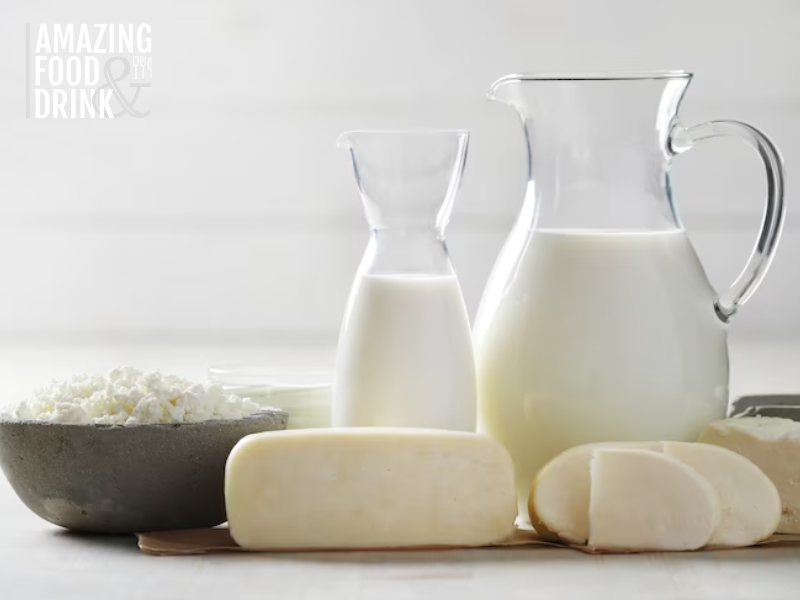Your Easy Delectable Lactose-Free Cheesecake Recipe
Creamy, dreamy, and oh-so-satisfying cheesecake is a classic dessert that everyone loves. But for those with lactose intolerance, indulging in a slice can mean an uncomfortable afternoon. Fear not, cheesecake lovers! This recipe for a lactose-free cheesecake is just as delicious as the original but without the tummy troubles.
In this article, we will demonstrate what lactose intolerance is and how serious this condition can be. Then, we will walk you through every step of an easy and delectable lactose-free cheesecake recipe, from making the crust to baking the cheesecake. We will also provide tips for topping your cheesecake and making it extra special.
So whether you are lactose intolerant yourself or just searching for a delicious and easy dessert recipe, this lactose-free cheesecake is the perfect solution.
Understanding Lactose Intolerance

Simply put, lactose is the sugar naturally found in milk and all dairy products. Chemically, it is a disaccharide composed of a couple of simple sugar molecules, glucose and galactose, linked together. Lactose is a primary source of energy in mammalian milk, providing essential nutrients for the growth and development of infants.
For the human body to utilise lactose, it needs to break it down to its individual sugar components by an enzyme called lactase, which is produced in the small intestine.
However, some individuals happen to have insufficient levels of lactase, leading to difficulties in digesting lactose. Without enough lactase, undigested lactose reaches the colon, leading to various symptoms in a condition known as lactose intolerance.
Symptoms
Lactose intolerance differs in severity among individuals, and while it is far from being life-threatening, it can significantly impact dietary choices and necessitate the avoidance or moderation of dairy consumption. Here are some of the most common symptoms caused by lactose intolerance:
- Flatulence: Incomplete lactose digestion in the small intestine results in fermentation by gut bacteria, causing the production of such gases as hydrogen and methane.
- Bloating: Excessive gas production can lead to abdominal bloating and discomfort.
- Diarrhoea: Unabsorbed lactose pulls water into the colon, causing loose and watery stools.
- Abdominal Pain: Cramping and pain in the abdominal region may occur due to the accumulation of gas and increased water content in the colon.
- Nausea: Some people may experience feelings of nausea after consuming lactose-containing foods.
- Fatigue: The malabsorption of lactose can affect nutrient absorption, potentially leading to fatigue and weakness.
Challenges
Individuals with lactose intolerance are often faced with several challenges that extend beyond mere dietary adjustments. These challenges can affect various aspects of daily life, including social, emotional, and practical considerations. Here are some key challenges often encountered by individuals managing a lactose-free diet:
- Limited Food Options: Many traditional and commonly enjoyed foods contain lactose. So, individuals on a lactose-free diet may find their food choices restricted, potentially leading to monotony in meals.
- Calcium Intake: Dairy products are a primary source of calcium, and individuals on a lactose-free diet may need to be mindful of alternative sources to maintain adequate calcium intake for bone health.
- Vitamin D Absorption: Lactose intolerance can affect vitamin D absorption, requiring individuals to monitor their vitamin D levels and potentially take supplements.
- Difficulty Dining Out: Eating at restaurants or social events can be challenging, as it may require careful scrutiny of menus and communication with chefs to ensure lactose-free options.
- Ingredient Awareness: Identifying lactose-containing ingredients on food labels can be intricate, as lactose may be listed under various names, and some processed foods may contain hidden sources of lactose.
- Cost of Specialty Products: Lactose-free or dairy-free alternatives can be a bit, or a lot, more expensive than their traditional counterparts, placing a financial burden on individuals managing a lactose-free diet.
Lactose-Free Cheesecake Recipe

As we just mentioned, it can be a bit hard for individuals with lactose intolerance to find alternatives to their favourite food, which incorporates dairy, let alone the countless desserts, from cakes and pastries to pies, puddings, and ice creams. A dessert like cheesecake is precisely problematic for individuals with lactose intolerance primarily because it relies heavily on dairy products.
More elaborately, cheesecakes use cream cheese as a staple in all traditional recipes. Many other cheesecake recipes call for butter and milk, both of which are rich in lactose. While these ingredients contribute to the creamy texture and flavour of the cheesecake, they do make it difficult for lactose intolerants to enjoy that creamy texture and flavour.
While lactose-free alternatives for milk are more readily available, finding lactose-free cream cheese or similar substitutes can be challenging. This limitation restricts the ability of individuals with lactose intolerance to easily adapt to traditional cheesecake recipes.
Yet, who said that challenging means impossible? In the next section, we are providing you with a delicious lactose-free cheesecake ready to be enjoyed by everyone, including those with lactose intolerance. This lactose-free recipe offers the same creamy texture and rich flavour as the traditional cheesecake without causing digestive discomfort.
The following ingredients are for making the crust, the filling, and the topping.
Ingredients
- 2 cups lactose-free cream cheese (softened)
- 1 cup lactose-free sour cream
- 1 1/2 cup granulated sugar
- 3 large eggs
- 1 teaspoon vanilla extract
- 1/4 cup cornstarch
- Zest of one lemon
- Pinch of salt
- 2 cups lactose-free graham cracker crumbs
- 1/2 cup lactose-free butter or dairy-free margarine (melted)
- 2 cups mixed berries (strawberries, blueberries, raspberries)
- 1 tablespoon fresh lemon juice
- 1 teaspoon cornstarch (optional, for thickening)
Recipe
Start by preheating your oven to 163°C. Grease a 23-cm springform pan with some lactose-free butter or dairy-free margarine.
Next, we prepare the crust. In a bowl, add half a cup of melted lactose-free butter, two cups of graham cracker crumbs, and a quarter cup of granulated sugar and mix them well. Press the mixture into the bottom of the greased springform pan, creating an even crust.
Bake the crust in the oven that is already heated for ten minutes. Remove the pan from the oven and let it cool while we prepare the filling.
To prepare the filling, add two cups of softened lactose-free cream cheese to a mixing bowl and beat it till smooth and creamy. Add the lactose-free sour cream, one cup of granulated sugar, and a quarter cup of cornstarch. Mix until well combined. Incorporate the eggs one by one and beat each one well. Add the vanilla extract, lemon zest, and a pinch of salt. Mix until the filling becomes smooth and velvety.
Now that everything is ready, it is time to assemble the cake and bake it.
First, pour the cheesecake filling over the cooled crust in the springform pan. With a spatula, smooth the top to ensure an even surface. Place the pan again in the heated oven and bake for around 50 minutes up to an hour, or until the centre is set and the edges are lightly golden. Turn off the oven and let the cheesecake cool in the oven with the door ajar for about an hour.
Take the cheesecake out of the oven and let it come to room temperature. Refrigerate for at least four hours or overnight.
Now, to the toppings.

Combine the mixed berries in a large bowl. If using strawberries, wash and chop them into bite-sized pieces.
Place your saucepan over medium-high heat, and add the mixed berries, a quarter cup of granulated sugar, and the fresh lemon juice. Stir gently to coat the berries in sugar. Allow the mixture to come to a simmer, then reduce the heat to low.
Let the berries simmer for 8-10 minutes, stirring occasionally. If you prefer a thicker compote, stir the cornstarch with one tablespoon of water to create a slurry. Add it to the berries and stir well. Continue to simmer until the compote reaches your desired thickness.
Once the berries have softened and the sugar has entirely dissolved, remove the saucepan from the stove. Allow the compote to get to room temperature.
Once fully chilled, take the cheesecake out of the refrigerator and run a sharp knife around the circle edge of the springform pan to loosen it. Then, release the sides of the pan and garnish the cheesecake with the berries topping. Place the cheesecake back in the refrigerator for an additional hour to allow the compote to set slightly.
Once set slightly, slice the cheesecake and serve it.
Flavour Variations and Toppings
Creating lactose-free cheesecakes does not mean sacrificing flavour diversity. In fact, there are numerous delicious options to explore besides the famous berry compote. Here are a few popular flavour variations for lactose-free cheesecakes:
- Citrus Zest and Drizzle: Add a burst of citrusy freshness with lemon, lime, or orange zest. You can also drizzle a bit of citrus juice for extra flavour.
- Dairy-Free Whipped Cream: Use whipped coconut cream or other dairy-free whipped toppings available in stores.
- Chocolate Ganache: Make a rich and smooth chocolate ganache using dairy-free chocolate and a lactose-free alternative to heavy cream.
- Caramel Sauce: Create a dairy-free caramel sauce using coconut milk or almond milk and brown sugar.
- Nut or Seed Butter Swirls: Swirl almond butter, peanut butter, or even sunflower seed butter on top for a nutty and satisfying twist.
- Fruit Slices: Decorate the cheesecake with slices of lactose-free fruits such as kiwi, pineapple, or peach.
- Fruit Jam or Jelly: Spread a thin layer of your preferred lactose-free fruit jam or jelly for a concentrated burst of fruity flavour.
- Maple Syrup Drizzle: Drizzle pure maple syrup over the cheesecake for a natural, sweet finish.
For all variations, ensure that any additional ingredients, such as toppings or mix-ins, are also lactose-free. Feel free to mix and match these ideas and come up with your own unique combination. These toppings not only enhance the flavour but also make your lactose-free cheesecake visually appealing.
These flavour options showcase the versatility of lactose-free cheesecakes, providing a delightful range of choices for individuals with lactose intolerance to enjoy without compromising taste or texture.
All in all, this lactose-free cheesecake is a testament to the fact that delicious desserts do not have to be complicated. With such simple ingredients and straightforward steps, you can create a showstopper that is kind to your tummy and pleases every palate.
So, next time you are craving cheesecake, do not let dietary restrictions hold you back. Whip up this lactose-free version and gather your loved ones around the table. With every smooth, creamy bite, you will realise that deliciousness knows no bounds and everyone deserves a slice of happiness. After all, who needs dairy when you have pure indulgence on your plate?

